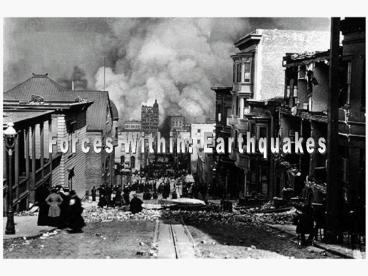Earthquakes - PowerPoint PPT Presentation
1 / 14
Title:
Earthquakes
Description:
Earthquakes are produced by the rapid release of elastic energy stored in rock ... Locating Earthquakes ... Earthquakes occur in narrow zones marking the ... – PowerPoint PPT presentation
Number of Views:83
Avg rating:3.0/5.0
Title: Earthquakes
1
Forces Within Earthquakes
2
What is an Earthquake?
An earthquake is the vibration of the Earth
caused by a rapid release of energy. The focus is
point in the Earth where the release of energy
originates. The location on the surface of the
Earth directly above the focus is called the
epicenter.
3
An earthquake occurred on the Erie Fault 5 km
below Ashtabula. Damage from the earthquake was
greatest in nearby Chardon. The furthest report
of shaking was recorded in Akron. Where was the
earthquake's epicenter?
- The Erie Fault
- Ashtabula
- Chardon
- Akron
4
The Elastic Rebound Theory
Earthquakes are produced by the rapid release of
elastic energy stored in rock that has been
subjected to stresses. Once the strength of the
rock is exceeded, it suddenly ruptures, causing
the vibrations of an earthquake.
5
Fault Movement
A fault is a fracture in Earths crust that shows
evidence of movement or displacement. Movement
along faults can be sideways or horizontal
(strike-slip) or vertical (dip-slip) as shown
here.
6
Earthquake Detection
Seismographs are instruments that record
earthquake waves. Essentially, a weight is
suspended from a support that is attached to
bedrock. When the bedrock vibrates, a pen records
the earthquake on a rotating drum.
7
Seismic Records
Records of the ground motion are called
seismograms. These are the sheets of paper
removed from the rotating drum of the seismograph.
8
Seismic Waves
- Seismograms reveal that there are two types of
seismic waves generated by rock slippage - Surface waves travel along the Earths outer
layer - Body waves travel through the Earths interior.
Body waves are further divided into primary and
secondary waves.
9
Seismic Waves
P waves are push-pull waves. P waves compress and
expand in the direction the wave is traveling. S
waves move up and down at right angles to their
direction of travel.
10
Seismic Wave Arrivals
Location Off the coast of Central America Date
January 13, 2001 Time 173329 Magnitude 7.1 Mw
P waves arrive at the recording station first,
then S waves , and finally surface waves. P waves
travel about 1.7 times faster than S waves.
11
Examine the seismogram below that shows a
26-minute long record of the seismic waves from
the 1906 San Francisco earthquake as it was
received by a seismograph station in Germany.
Approximately how much time elapsed between the
arrival of the first P and S waves?
- 60 seconds
- 4 minutes
- 10 minutes
- 20 minutes
12
Locating Earthquakes
The difference in velocities of P and S waves
provides a method for locating the epicenter. The
greater the length of the time between the first
arriving P and S waves, the greater the distance
the earthquake is away.
In this example, an interval of 5 minutes
indicates the earthquake was 3400 km away from
the recorder.
13
Locating Earthquakes
From the travel-time graph we get the distance to
the earthquake, but how can we figure out the
direction?? The precise location can be found if
three seismic stations recorded the earthquake.
14
Earthquake Distributions
Earthquakes occur in narrow zones marking the
boundaries of the main plates.































